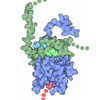[English] 日本語
 Yorodumi
Yorodumi- PDB-6wj3: CryoEM structure of the SLC38A9-RagA-RagC-Ragulator complex in th... -
+ Open data
Open data
- Basic information
Basic information
| Entry | Database: PDB / ID: 6wj3 | ||||||
|---|---|---|---|---|---|---|---|
| Title | CryoEM structure of the SLC38A9-RagA-RagC-Ragulator complex in the post-GAP state | ||||||
 Components Components |
| ||||||
 Keywords Keywords | SIGNALING PROTEIN / small GTPase / mTORC1 activation / amino acid signaling / lysosome | ||||||
| Function / homology |  Function and homology information Function and homology informationasparagine transport / L-asparagine transmembrane transporter activity / sterol sensor activity / L-arginine transmembrane transporter activity / L-arginine transmembrane transport / regulation of cholesterol import / positive regulation of protein localization to lysosome / regulation of cell-substrate junction organization / Gtr1-Gtr2 GTPase complex / regulation of cholesterol efflux ...asparagine transport / L-asparagine transmembrane transporter activity / sterol sensor activity / L-arginine transmembrane transporter activity / L-arginine transmembrane transport / regulation of cholesterol import / positive regulation of protein localization to lysosome / regulation of cell-substrate junction organization / Gtr1-Gtr2 GTPase complex / regulation of cholesterol efflux / L-glutamine transmembrane transporter activity / glutamine transport / FNIP-folliculin RagC/D GAP / Ragulator complex / protein localization to cell junction / L-leucine transmembrane transporter activity / amino acid transmembrane transport / L-amino acid transmembrane transporter activity / regulation of TORC1 signaling / protein localization to lysosome / regulation of TOR signaling / MTOR signalling / fibroblast migration / Amino acids regulate mTORC1 / lysosome localization / Energy dependent regulation of mTOR by LKB1-AMPK / endosome organization / TORC1 signaling / amino acid transmembrane transporter activity / kinase activator activity / protein localization to membrane / arginine binding / endosomal transport / azurophil granule membrane / lysosome organization / cholesterol binding / small GTPase-mediated signal transduction / Macroautophagy / regulation of cell size / RHOJ GTPase cycle / RHOQ GTPase cycle / mTORC1-mediated signalling / CDC42 GTPase cycle / tertiary granule membrane / RHOH GTPase cycle / ficolin-1-rich granule membrane / RHOG GTPase cycle / regulation of receptor recycling / RAC2 GTPase cycle / positive regulation of TOR signaling / RAC3 GTPase cycle / enzyme-substrate adaptor activity / response to amino acid / cellular response to nutrient levels / specific granule membrane / protein-membrane adaptor activity / RAC1 GTPase cycle / positive regulation of TORC1 signaling / negative regulation of autophagy / cellular response to amino acid starvation / RNA splicing / guanyl-nucleotide exchange factor activity / viral genome replication / cholesterol homeostasis / cellular response to starvation / Regulation of PTEN gene transcription / tumor necrosis factor-mediated signaling pathway / positive regulation of interleukin-8 production / TP53 Regulates Metabolic Genes / cellular response to amino acid stimulus / phosphoprotein binding / regulation of cell growth / MAP2K and MAPK activation / positive regulation of protein localization to nucleus / response to virus / GDP binding / late endosome membrane / intracellular protein localization / late endosome / glucose homeostasis / E3 ubiquitin ligases ubiquitinate target proteins / GTPase binding / molecular adaptor activity / Hydrolases; Acting on acid anhydrides; Acting on GTP to facilitate cellular and subcellular movement / lysosome / positive regulation of canonical NF-kappaB signal transduction / positive regulation of MAPK cascade / endosome membrane / intracellular signal transduction / membrane raft / protein heterodimerization activity / lysosomal membrane / focal adhesion / intracellular membrane-bounded organelle / GTPase activity / apoptotic process / DNA-templated transcription / ubiquitin protein ligase binding / Neutrophil degranulation / positive regulation of gene expression Similarity search - Function | ||||||
| Biological species |  Homo sapiens (human) Homo sapiens (human) | ||||||
| Method | ELECTRON MICROSCOPY / single particle reconstruction / cryo EM / Resolution: 3.9 Å | ||||||
 Authors Authors | Fromm, S.A. / Hurley, J.H. | ||||||
| Funding support |  United States, 1items United States, 1items
| ||||||
 Citation Citation |  Journal: Nat Struct Mol Biol / Year: 2020 Journal: Nat Struct Mol Biol / Year: 2020Title: Structural mechanism for amino acid-dependent Rag GTPase nucleotide state switching by SLC38A9. Authors: Simon A Fromm / Rosalie E Lawrence / James H Hurley /  Abstract: The Rag GTPases (Rags) recruit mTORC1 to the lysosomal membrane in response to nutrients, where it is then activated in response to energy and growth factor availability. The lysosomal folliculin ...The Rag GTPases (Rags) recruit mTORC1 to the lysosomal membrane in response to nutrients, where it is then activated in response to energy and growth factor availability. The lysosomal folliculin (FLCN) complex (LFC) consists of the inactive Rag dimer, the pentameric scaffold Ragulator, and the FLCN:FNIP2 (FLCN-interacting protein 2) GTPase activating protein (GAP) complex, and prevents Rag dimer activation during amino acid starvation. How the LFC is disassembled upon amino acid refeeding is an outstanding question. Here we show that the cytoplasmic tail of the human lysosomal solute carrier family 38 member 9 (SLC38A9) destabilizes the LFC and thereby triggers GAP activity of FLCN:FNIP2 toward RagC. We present the cryo-EM structures of Rags in complex with their lysosomal anchor complex Ragulator and the cytoplasmic tail of SLC38A9 in the pre- and post-GTP hydrolysis state of RagC, which explain how SLC38A9 destabilizes the LFC and so promotes Rag dimer activation. | ||||||
| History |
|
- Structure visualization
Structure visualization
| Movie |
 Movie viewer Movie viewer |
|---|---|
| Structure viewer | Molecule:  Molmil Molmil Jmol/JSmol Jmol/JSmol |
- Downloads & links
Downloads & links
- Download
Download
| PDBx/mmCIF format |  6wj3.cif.gz 6wj3.cif.gz | 224.1 KB | Display |  PDBx/mmCIF format PDBx/mmCIF format |
|---|---|---|---|---|
| PDB format |  pdb6wj3.ent.gz pdb6wj3.ent.gz | 168.6 KB | Display |  PDB format PDB format |
| PDBx/mmJSON format |  6wj3.json.gz 6wj3.json.gz | Tree view |  PDBx/mmJSON format PDBx/mmJSON format | |
| Others |  Other downloads Other downloads |
-Validation report
| Summary document |  6wj3_validation.pdf.gz 6wj3_validation.pdf.gz | 1.5 MB | Display |  wwPDB validaton report wwPDB validaton report |
|---|---|---|---|---|
| Full document |  6wj3_full_validation.pdf.gz 6wj3_full_validation.pdf.gz | 1.6 MB | Display | |
| Data in XML |  6wj3_validation.xml.gz 6wj3_validation.xml.gz | 49 KB | Display | |
| Data in CIF |  6wj3_validation.cif.gz 6wj3_validation.cif.gz | 71 KB | Display | |
| Arichive directory |  https://data.pdbj.org/pub/pdb/validation_reports/wj/6wj3 https://data.pdbj.org/pub/pdb/validation_reports/wj/6wj3 ftp://data.pdbj.org/pub/pdb/validation_reports/wj/6wj3 ftp://data.pdbj.org/pub/pdb/validation_reports/wj/6wj3 | HTTPS FTP |
-Related structure data
| Related structure data |  21687MC  6wj2C M: map data used to model this data C: citing same article ( |
|---|---|
| Similar structure data |
- Links
Links
- Assembly
Assembly
| Deposited unit | 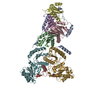
|
|---|---|
| 1 |
|
- Components
Components
-Ragulator complex protein ... , 5 types, 5 molecules ABCDE
| #1: Protein | Mass: 18325.350 Da / Num. of mol.: 1 / Mutation: G2A Source method: isolated from a genetically manipulated source Source: (gene. exp.)  Homo sapiens (human) / Gene: LAMTOR1, C11orf59, PDRO, PP7157 / Production host: Homo sapiens (human) / Gene: LAMTOR1, C11orf59, PDRO, PP7157 / Production host:  |
|---|---|
| #2: Protein | Mass: 13645.579 Da / Num. of mol.: 1 Source method: isolated from a genetically manipulated source Source: (gene. exp.)  Homo sapiens (human) / Gene: LAMTOR2, MAPBPIP, ROBLD3, HSPC003 / Production host: Homo sapiens (human) / Gene: LAMTOR2, MAPBPIP, ROBLD3, HSPC003 / Production host:  |
| #3: Protein | Mass: 13637.678 Da / Num. of mol.: 1 Source method: isolated from a genetically manipulated source Source: (gene. exp.)  Homo sapiens (human) / Gene: LAMTOR3, MAP2K1IP1, MAPKSP1, PRO2783 / Production host: Homo sapiens (human) / Gene: LAMTOR3, MAP2K1IP1, MAPKSP1, PRO2783 / Production host:  |
| #4: Protein | Mass: 10753.236 Da / Num. of mol.: 1 Source method: isolated from a genetically manipulated source Source: (gene. exp.)  Homo sapiens (human) / Gene: LAMTOR4, C7orf59 / Production host: Homo sapiens (human) / Gene: LAMTOR4, C7orf59 / Production host:  |
| #5: Protein | Mass: 18178.520 Da / Num. of mol.: 1 Source method: isolated from a genetically manipulated source Source: (gene. exp.)  Homo sapiens (human) / Gene: LAMTOR5, HBXIP, hCG_40252 / Production host: Homo sapiens (human) / Gene: LAMTOR5, HBXIP, hCG_40252 / Production host:  |
-Ras-related GTP-binding protein ... , 2 types, 2 molecules FG
| #6: Protein | Mass: 39362.078 Da / Num. of mol.: 1 Source method: isolated from a genetically manipulated source Source: (gene. exp.)  Homo sapiens (human) / Gene: RRAGA / Production host: Homo sapiens (human) / Gene: RRAGA / Production host:  |
|---|---|
| #7: Protein | Mass: 44758.336 Da / Num. of mol.: 1 / Mutation: D181N Source method: isolated from a genetically manipulated source Source: (gene. exp.)  Homo sapiens (human) / Gene: RRAGC / Production host: Homo sapiens (human) / Gene: RRAGC / Production host:  |
-Protein , 1 types, 1 molecules H
| #8: Protein | Mass: 13610.139 Da / Num. of mol.: 1 Source method: isolated from a genetically manipulated source Source: (gene. exp.)  Homo sapiens (human) / Gene: SLC38A9, URLC11 / Cell line (production host): HEK293 / Production host: Homo sapiens (human) / Gene: SLC38A9, URLC11 / Cell line (production host): HEK293 / Production host:  Homo sapiens (human) / References: UniProt: Q8NBW4 Homo sapiens (human) / References: UniProt: Q8NBW4 |
|---|
-Non-polymers , 2 types, 2 molecules 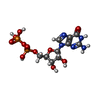


| #9: Chemical | ChemComp-GDP / |
|---|---|
| #10: Chemical | ChemComp-U3J / |
-Details
| Has ligand of interest | N |
|---|
-Experimental details
-Experiment
| Experiment | Method: ELECTRON MICROSCOPY |
|---|---|
| EM experiment | Aggregation state: PARTICLE / 3D reconstruction method: single particle reconstruction |
- Sample preparation
Sample preparation
| Component |
| |||||||||||||||||||||||||||||||||||
|---|---|---|---|---|---|---|---|---|---|---|---|---|---|---|---|---|---|---|---|---|---|---|---|---|---|---|---|---|---|---|---|---|---|---|---|---|
| Molecular weight | Value: 0.17 MDa / Experimental value: NO | |||||||||||||||||||||||||||||||||||
| Source (natural) |
| |||||||||||||||||||||||||||||||||||
| Source (recombinant) |
| |||||||||||||||||||||||||||||||||||
| Buffer solution | pH: 7.4 | |||||||||||||||||||||||||||||||||||
| Specimen | Conc.: 0.5 mg/ml / Embedding applied: NO / Shadowing applied: NO / Staining applied: NO / Vitrification applied: YES | |||||||||||||||||||||||||||||||||||
| Specimen support | Grid material: COPPER / Grid mesh size: 300 divisions/in. / Grid type: C-flat-2/1 | |||||||||||||||||||||||||||||||||||
| Vitrification | Instrument: FEI VITROBOT MARK IV / Cryogen name: ETHANE / Humidity: 100 % / Chamber temperature: 277 K |
- Electron microscopy imaging
Electron microscopy imaging
| Experimental equipment |  Model: Talos Arctica / Image courtesy: FEI Company |
|---|---|
| Microscopy | Model: FEI TALOS ARCTICA |
| Electron gun | Electron source:  FIELD EMISSION GUN / Accelerating voltage: 200 kV / Illumination mode: FLOOD BEAM FIELD EMISSION GUN / Accelerating voltage: 200 kV / Illumination mode: FLOOD BEAM |
| Electron lens | Mode: BRIGHT FIELD |
| Image recording | Average exposure time: 5.7 sec. / Electron dose: 60.5 e/Å2 / Film or detector model: GATAN K3 (6k x 4k) / Num. of grids imaged: 1 |
- Processing
Processing
| Software | Name: PHENIX / Version: dev_3736: / Classification: refinement | ||||||||||||||||||||||||||||
|---|---|---|---|---|---|---|---|---|---|---|---|---|---|---|---|---|---|---|---|---|---|---|---|---|---|---|---|---|---|
| EM software |
| ||||||||||||||||||||||||||||
| CTF correction | Type: PHASE FLIPPING AND AMPLITUDE CORRECTION | ||||||||||||||||||||||||||||
| Particle selection | Num. of particles selected: 2309565 | ||||||||||||||||||||||||||||
| Symmetry | Point symmetry: C1 (asymmetric) | ||||||||||||||||||||||||||||
| 3D reconstruction | Resolution: 3.9 Å / Resolution method: FSC 0.143 CUT-OFF / Num. of particles: 106659 / Symmetry type: POINT | ||||||||||||||||||||||||||||
| Atomic model building | Space: REAL | ||||||||||||||||||||||||||||
| Refine LS restraints |
|
 Movie
Movie Controller
Controller





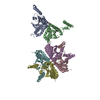
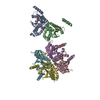
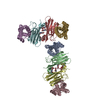
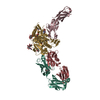

 PDBj
PDBj
